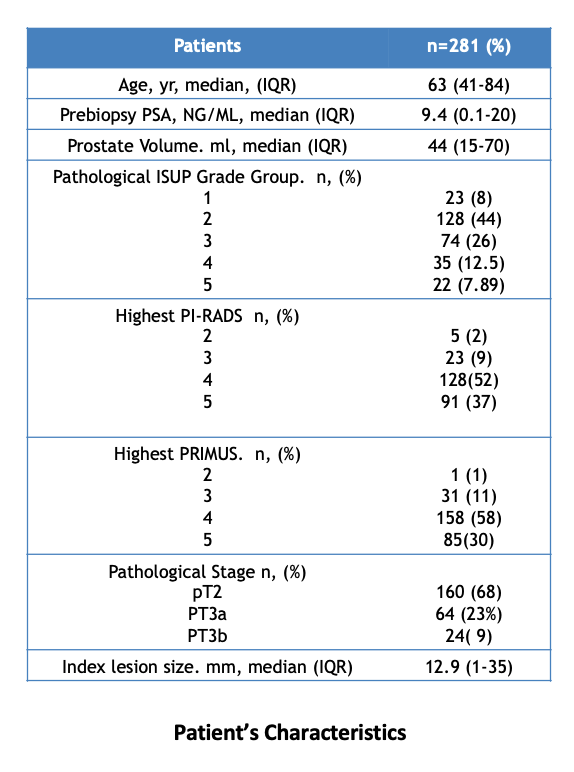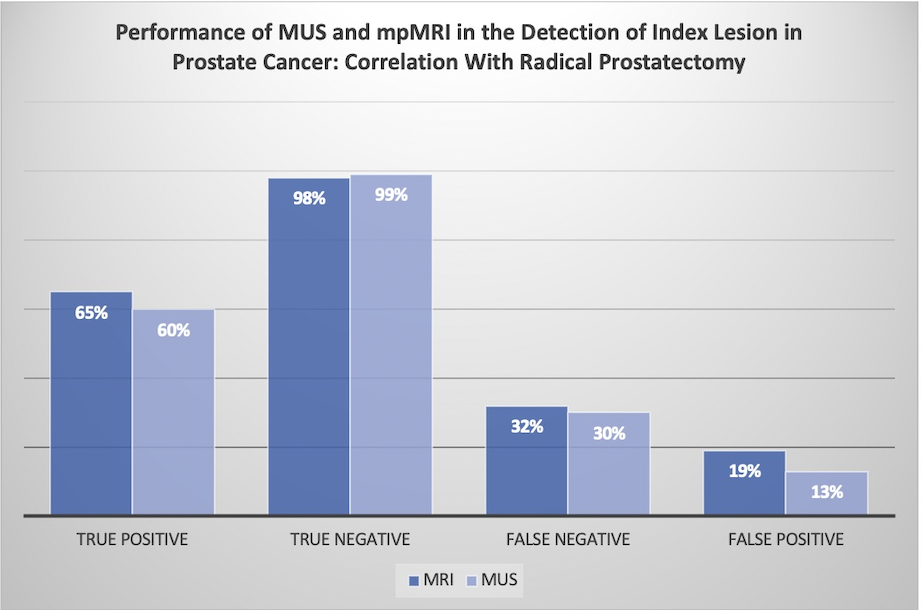Back
Introduction: The natural history of PCa is driven by an index lesion (IL), which is often either the largest in size and/or highest in grade. By analyzing genome-wide single nucleotide polymorphisms and copy number variations, researchers have been able to show that the vast majority of metastatic prostate cancers have monoclonal origins. Therefore, the identification of IL plays a key role in treatment decision-making. Microultrasound (MUS) provides a resolution of up to 70 microns. Evidence seems to suggest comparable performance to mpMRI in the identification of clinically significant prostate cancer. The goal of our study is to evaluate the accuracy of a transrectal MUS for the detection of the IL in prostate cancer compared to mpMRI.
Methods: Two hundred and eighty-one patients who underwent robot-assisted radical prostatectomy (RARP) from June 2021 to May 2022 were included. All received mpMRI and MUS within three months prior to RARP. MUS was performed by experienced urologists blinded to mpMRI and biopsy results. The IL in the radical prostatectomy specimen was defined as the lesion with extraprostatic extension, the highest Gleason Score (GS), or the largest tumor volume if the GS was the same. A correlation between imaging and final pathology findings was performed. A descriptive statistical analysis is presented.
Results: The patients’ prostates were analyzed in 12 regions (anterior/posterior, right/left, apex/mid/base). A total of 3,372 regions were identified. Of these, 731 were involved by the IL. Compared to final pathology, MUS demonstrated a sensitivity, specificity, PPV, and NPV of 66%, 96%, 81%, and 92%, respectively, while mpMRI showed a sensitivity, specificity, PPV, and NPV of 66%, 97%, 87%, and 91%, respectively, for the detection of the IL. Most of the lesions missed by MUS were located in the anterior zone (62%).
Conclusions: MUS has comparable diagnostic performance to mpMRI in identifying prostate cancer index lesion. MUS is less expensive, provides a real-time anatomic evaluation, and has no lag in the acquisition process. Prospective randomized trials are needed to verify our results. SOURCE OF
Funding: none


Moderated Poster Session
Session: MP40: Prostate Cancer: Detection & Screening I
MP40-16: Microultrasound in the Detection of the Index Lesion in Prostate Cancer
Saturday, April 29, 2023
1:00 PM – 3:00 PM CST
Location: S405

Adriana Marcela Pedraza Bermeo, MD
Mount Sinai Hospital
Poster Presenter(s)
Introduction: The natural history of PCa is driven by an index lesion (IL), which is often either the largest in size and/or highest in grade. By analyzing genome-wide single nucleotide polymorphisms and copy number variations, researchers have been able to show that the vast majority of metastatic prostate cancers have monoclonal origins. Therefore, the identification of IL plays a key role in treatment decision-making. Microultrasound (MUS) provides a resolution of up to 70 microns. Evidence seems to suggest comparable performance to mpMRI in the identification of clinically significant prostate cancer. The goal of our study is to evaluate the accuracy of a transrectal MUS for the detection of the IL in prostate cancer compared to mpMRI.
Methods: Two hundred and eighty-one patients who underwent robot-assisted radical prostatectomy (RARP) from June 2021 to May 2022 were included. All received mpMRI and MUS within three months prior to RARP. MUS was performed by experienced urologists blinded to mpMRI and biopsy results. The IL in the radical prostatectomy specimen was defined as the lesion with extraprostatic extension, the highest Gleason Score (GS), or the largest tumor volume if the GS was the same. A correlation between imaging and final pathology findings was performed. A descriptive statistical analysis is presented.
Results: The patients’ prostates were analyzed in 12 regions (anterior/posterior, right/left, apex/mid/base). A total of 3,372 regions were identified. Of these, 731 were involved by the IL. Compared to final pathology, MUS demonstrated a sensitivity, specificity, PPV, and NPV of 66%, 96%, 81%, and 92%, respectively, while mpMRI showed a sensitivity, specificity, PPV, and NPV of 66%, 97%, 87%, and 91%, respectively, for the detection of the IL. Most of the lesions missed by MUS were located in the anterior zone (62%).
Conclusions: MUS has comparable diagnostic performance to mpMRI in identifying prostate cancer index lesion. MUS is less expensive, provides a real-time anatomic evaluation, and has no lag in the acquisition process. Prospective randomized trials are needed to verify our results. SOURCE OF
Funding: none


